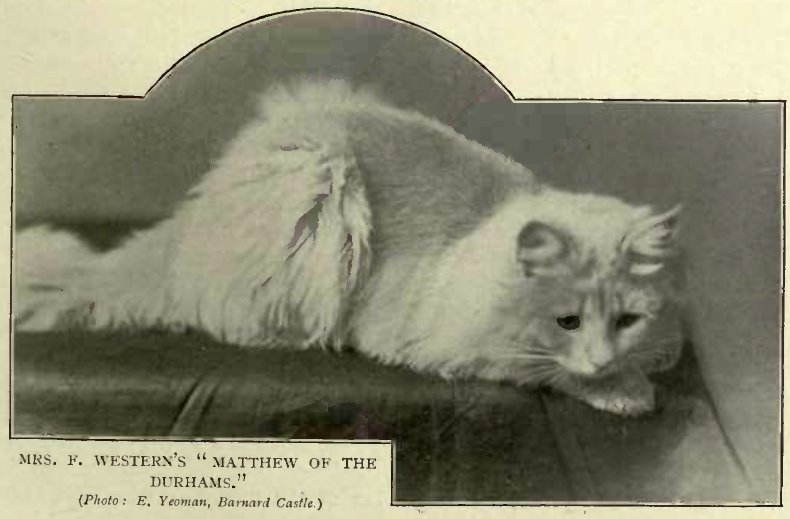XVI. CREAM OR FAWN PERSIANS
Texte und Bilder aus “THE BOOK OF THE CAT” von Frances Simpson aus dem Jahre 1903
THE BOOK OF THE CAT
CHAPTER XVI.
CREAM OR FAWN PERSIANS
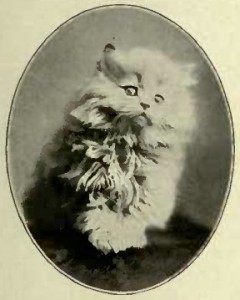
This may be said to be the very latest variety in Persian breeds, and one which bids fair to become very fashionable. The term “ cream “ describes exactly what is the desired tint of these cats, but few and far between are the specimens which are pale and even enough in colour to be correctly described as creams. No doubt, in times past now and again a cream cat would be seen exhibited in the “ any variety “ class, but then they might be designated as freaks or flukes. Now, however, fanciers of these cats have a system in their matings, and therefore, as a result, there is a breed of cats established which until late years were not recognised or classified.
It is true that the cream Persians seen in the show pens are often much darker than is implied by the name, and, indeed, are really fawn-coloured. The great thing, however, is to obtain an even tint throughout, whether dark or light, and to avoid any patches, streaks, or tabby markings. I think the very pale creams are more dainty and fascinating than the darker cats, but the lighter the coat the more difficult it is to obtain perfect uniformity of colour. Of course, there will always be a certain amount of shading in cream cats—that is, the spine-line will be slightly darker, shading off on the sides and under the stomach and tail. I think that creams are making more rapid strides towards attaining the “ almost unmarked “
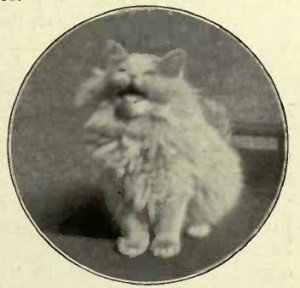
stage than are silvers. Certainly, good creams of to-day are very slightly barred on head or legs or tail, and this cannot be said as regards some of our best silver cats. This is probably to be accountgd_for by the cautious and wise discrimination used in mating creams by selecting blues or tortoiseshells, and thus avoiding tabby-marked cats. It is a peculiarity of cream cats that the eyes are generally almond-shaped, and are set rather slanting in the head. It is rare and a great treat to see bold, round, owl-like eyes in cream cats. These in colour should be golden or hazel, the brighter the colour the better. I will here give the points of cream or fawn cats, as drawn up by the specialist society :—
CREAM OR FAWN.
Colour. —To be as pure as possible without marking or shading, either paler or darker, dulness and white to be particularly avoided. All shades from the palest fawn to be allowable. 25.
Coat. —To be very long and fluffy. 25.
Size and shape. —To be large—not coarse, but massive, with plenty of bone and substance ; short legs. 20.
Head. —To be round and broad, with short nose, ears small and well opened. 15.
Eyes. —To be large and full, and bright orange or hazel in colour. 5.
Condition. —10.
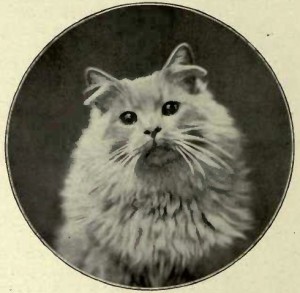
Much has been done by this energetic specialist society to get a better classifica-t i o n f o r creams at our shows ; and p e r-haps,astime goes on and a larger number of fanciers take up these breeds, a distinct classification will be given for creams and fawns. It may always be a little difficult to draw the line between the two ; but such a division of colours would, I think, give satisfaction to the breeders of both creams and fawns, for at present judges are more inclined to give a preference to the palest – coloured cats, perhaps because more beautiful and more difficult to breed.
In the former breeds, more especially blues and silvers, that I have described in this work it would have been impossible to name all those cats that were noted in the fancy, for the simple reason that their name is legion ; but it is different in a breed like creams, for, as I mentioned in the beginning of this chapter, in times past it was a case of only here and there a cream Persian appearing on the scene, then vanishing perhaps to America, or else being purchased for a pet and retiring from public life. These “ sports “ in the fancy were not seriously taken up, and no one thought of trying to establish a strain; so that one can, as it were, put one’s finger on the cats of this variety, if not so easily in the present day, certainly in the past.
The first recorded cream Persian in catalogues or stud books is “ Cupid Bassanio,“ born in 1890, bred by Mrs. Kinchant ; no pedigree is given. He was a big, broad-headed, heavily coated cat, with a good many marks and shadings, and was sold to Mrs. Preston Whyte, and passed on to Miss Norman. In the same year Mrs. Kinchant exhibited cream kittens at Brighton. “ Ripon“ was another well-known cream of imported parents (a blue and an orange). This cat was purchased from Mrs. Foote by Lady Marcus Beresford, and eventually disappeared when in the possession of Miss Cockburn Dickinson. Mr. McLaren Morrison in 1893 owned a pale cat called “ Devonshire Cream.“ In the following year Miss Taylor bred a splendid specimen from “ Tawny,“ her noted tortoise-shell. This cat, called “ Fawn,“ was an absolutely self – coloured fawn with brown eyes, and would do some winning if alive now to compete in our up-to-date classes for cream or fawn. It was in 1895 that Miss Beal first exhibited some of her creams, upon which at that time she did not set much store, more interested as she was in blues ; but of her now celebrated strain more anon.
One of the best-known creams of late years is “ Zoroaster,“ bred by Mrs. Bagster from her tortoiseshell „Pixie.“ This was a remarkably large pale cat with glorious eyes, but he was a good deal patched in colour when I saw him at Mrs. Mackenzie Stewart’s cattery. Mrs. Cartwright bred a well-shaped light cream, “ Upwood Junket,“ by “ Timkins,“ a blue, and a daughter of “ Cyrus the Elamite.“ Mrs. Davies, of Caterham, has often had creams in her possession, notably “ Lord Cremorne,“ quite one of the palest seen in the show pen. Two noted creams now placed at stud are Mrs. Norris’s “ Kew Ronald “ and Mrs. Western’s “ Matthew of the Durhams.“ Both these cats arc bred from Miss Beal’s famous “ Heavenly Twins.“ Regarding “ Matthew,“ a reporter in Our Cats thus writes after the Botanic show of 1901 :— “ Creams are, we prophesy, the coming cats. There seems to us great possibilities in this variety. ‚ Matthew of the Durhams ‚ ‚is one of the cats we would bring forward in support of this view. Eminently aristocratic, breathing an air of refinement, this cat might be the petted darling of a princess whose cats are all selected by a connoisseur.“ Mr. Western is justly proud of his purchase, for he claimed this fine cat at the Sandy show, 1901, when he was exhibited by Mrs. D’Arcy Hildyard. “ Matthew “ has on four separate occasions taken second to his father „.Admiral’s “ first. He has sired some lovely creams, notably “ Wynnstay Myrtle,“ also owned by Mrs. F. Western. This female is one of the best of her breed, and is sure to have some influence over the creams of the future. At the Crystal Palace show of 1902, where she was awarded first and many specials, she was the admired of all admirers. As a rule, cream females have been very much behind the males in quantity and quality. Almost the first two were bred by Miss Hester Coch-r a n e from „Cyrus the Elamite“ and „Brunette.“ „Creme d’Or“ is quite one of the best, and was owned by Mrs. Wellbye, who sold her to Mrs.Xorris. This cat declined to enter into any matrimonial alliance for some time, but at last presented her owner with a family by “ Darius,“ Mrs. Ransome’s noted blue. Two of these cats, “ Kew Laddie “ and “ Kew Ronald,“ are well known in their different spheres. “ Kew Laddie“ I purchased to send out to Mrs. Clinton Locke, in Chicago, and she presented him to the honorary secretary of the Beresford Club, Miss Johnstone. This lady exhibited “ Laddie “ at the big Chicago Cat Show, where he won high honours, and in a letter received from Miss Johnstone I learn he is growing a grand fellow and, in fact, is quite la creme de la creme in catty society over the water.
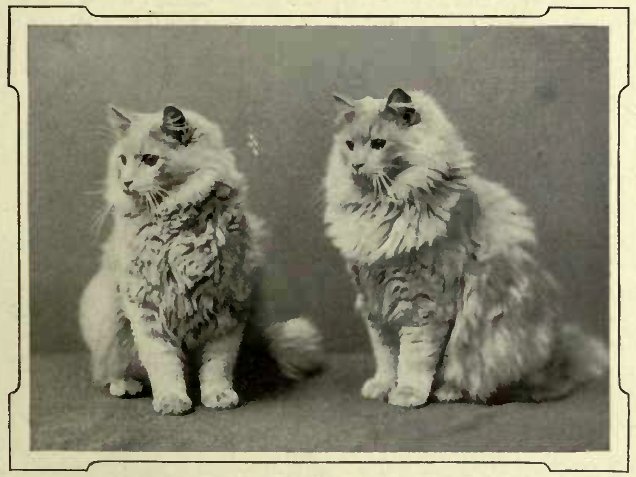
The picture of a perfect kitten on the opening page of this chapter represents a cream female, “ Jessica Kew,“ bred by Mrs. Clinton Locke from “ Lockhaven Daffodil,“ sired by Miss Johnstone’s “ Laddie Kew.“ Mrs. Clinton Locke is justly proud of this lovely kitten, and writes: „Jessica is the finest kitten I have ever seen ; all her points are perfect. She was five weeks old when this photo was taken. Her grandfather was my ‚ Victor,‘ an orange, her great-grandmother a tortoiseshell – and-white.“
I have mentioned Mr. F. Norris as a breeder of creams and the owner of the handsome pair of cats illustrated on this page. He has kindly supplied me with the following notes: „Cream cats are of a modern colour in Persians, but are now being more freely bred and finding numerous supporters. There are, however, very for size and The great few good ones in the fancy, colour are difficult to obtain.
failing with them is that, although they are called cream cats, the best and soundest coloured ones are really of a fawn shade. So many show markings, patches, or shadings, whereas the colour should be one shade and sound throughout ; better be a little dark in colour rather than shade from cream to white, as is the case with so many specimens exhibited.
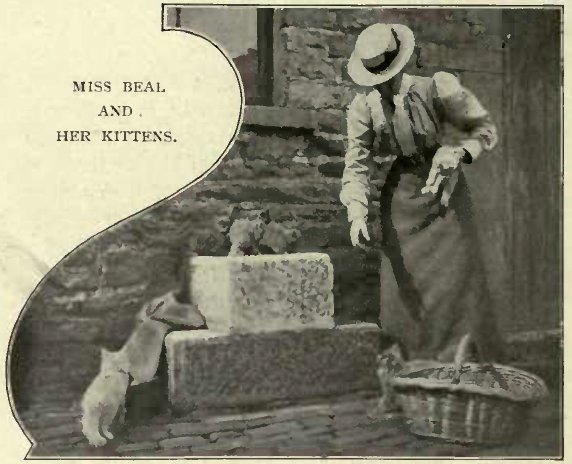
„For one grand-headed and good-eyed cot you see a dozen snipy, long-faced ones with curious slit eyes, instead of a short, snub head, with glorious big round golden eyes.
“ In my opinion, to get the short head, good eye, fine body shape, and short legs, it is best to mate a cream with a good cobby blue. From my experience nothing beats a blue, although you can mate them with a red, tortoiseshell, or black. Mating two creams together I do not advocate, unless one of them has a distinct out-cross in the first generation to totally different blood.
„All the creams shown are descended from Miss Beal’s two brothers‘ Romald-kirk Admiral‘ and ‚ Romaldkirk Mid-shipmite,‘ and to keep the colour, breeders have bred in and into them again ; and that is why they have lost so much in type and character, which would have been improved by using an out-cross.
“ I have heard people say, ‚ Cream females will not breed.‘ If they only studied the question a minute, they would know the reason well enough, which is that they have been too much in-bred. If breeders will only try the blue cross more, they will, I am sure, be pleased, and we shall see a better cat being shown. Breeding from blue you will get pure creams and some cream and blue mixed. Keep the blue and cream females, and when old enough mate them to a cream, and you will get some fine sound-coloured cream kits.
“ It is very curious that there has been nothing yet bred in males to beat the twin cats ‚ Admiral ‚ and ‚ Mid-shipmite.‘
“ In females the best I have seen is ‚ Miriam of the Durhams,‘ who has a lovely body and coat, but is long in face and has those bad-shaped eyes. ‚ Creme d’Or‘ runs her close, as she has such a good head, with perfect eye, but is a wee bit long in the leg.“ Miss Beal’s females „Calliope“ and „Mignonette “ were both noted prize-winning cream females. Mrs. D’Arcy Hildyard has been most successful in her endeavours to breed creams from creams, and a letter from her in Our Cats of April, IQOI, will be interesting to breeders of this variety :—
BREEDING OF CREAMS.
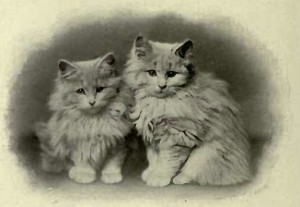
SIR, —Being much interested in the breeding of creams, I should like to say a few words on the subject and state my experience. Though only a novice, I have up to date succeeded in breeding twenty creams—two in 1899, thirteen in 1900, and seven this year. I began by mating my mixed blue and cream queen “ Senga “ to a cream torn “ D’Arcy,“ which I bought from Mr. Hutchinson, of Egglestone. From this pair I got four kittens, all females—two cream and two marked blues. I kept the creams “ Josephine “ and “ Hazeline,“ winners at Westminster as kittens, first and second special and medal, 1900. Later on in the year I mated them, “ Hazeline“ to Miss Beal’s “ Midshipmite,“ “ Josephine “ to her “ Admiral.“ Both litters were entirely cream, “ Josephine “ producing six kittens, “ Hazeline “ producing five, two of which I have kept. “ Matthew “ and “ Miriam of the Durhams “ both won as kittens at Manchester, and “ Miriam “ has since taken first and specials at Barnard Castle, Westminster, and Reading. “ Matthew “ is growing into a very handsome cat, and I hope to exhibit him at the Botanic. On Saturday last, April ijth, “ Hazeline “ again kittened and produced five creams, having again been mated to “ Midshipmite. ‚ This I think distinctly proves that good ci earns can be got from a pair of the same colour. On April i4th “ Senga “ also presented me with two more creams, also two marked blues, this time the result of a mating with Miss Beale’s “ Romaldkirk Toza.“
AGNES D’ARCY HILDYARD.
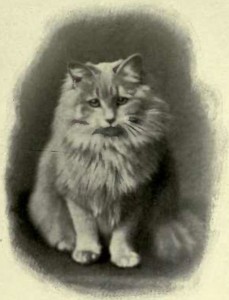
Mrs. Barton Collier has two good creams, „Bruin“ and „Dolly of Brough.“ Again these cats are from Miss Beal’s strain, the male being a fawn and the female quite one of the palest of creams.
Miss H. Cochran, who formerly took a great interest in this breed, writes :—“ I should be inclined to mate a pale cream male or female with a white, and the progeny with an unmarked orange, or vice versa. I had a litter from ‚ Buttercup ‚ and ‚ Zoroaster,‘ consisting of two oranges, two fawns, and a cream. The fawn and creams were females, but all died in their youth. I made other attempts with similar crosses, as I had been told it was impossible to breed cream queens, and in the first year all the creams were queens, and the males red ! My idea was to select a male of the required colour, and mate a queen of suitable breeding with him, then to mate the resulting queens with their own father. I believe this plan would have been a success if I had followed it up. My idea is that the natural males are the fawns and oranges, and that their complementary queens are the blue tortoiseshells and the ordinary tortoiseshells. No harm is ever done to a cream or orange strain by crossing with black, and it may do much good to the latter by deepening the colour of the oranges, and promoting patchiness as opposed to streakiness in the tortoiseshells.“
I have made frequent mention of Miss Beal’s noted creams during my chapters on orange and cream cats. These two celebrated champions are commonly known in the fancy as the “ Heavenly Twins,“ their registered names being “ Romaldkirk Admiral “ and “ Romaldkirk Midshipmite.“ They are really fawn Persian cats, very sound in colour, well made, big boned, and are always exhibited in the pink of condition, and at all seasons of the year are in marvellous coat. Certainly, the cold climate of the Romaldkirk cattery, which is situated 730 feet above the sea level, must, anyhow, suit this variety of Persian cat. I suppose the day will come when these well tried and well-seasoned veterans will have to retire from public life and make way for some of their already noted offspring. In the North, South, East, and West these “ Heavenly Twins“ have reigned supreme, and Miss Beal must almost have lost count of the number of prizes won by them, which, I think I am safe in saying, would give an exact record of the number of times exhibited. In response to my request, Miss Beal has sent me some notes regarding her cattery arrangements, She says :— “ Most of the houses old farm are buildings round about our stable yard, and I have recently utilised an old granary which is over the coachhouse. This is about 40 feet long, and has a room at one end, with five windows and good ventilation above. In addition I have three big cat houses and a loft, where most of the queens reside. ‚ Middy‘ and ‚ Admiral‘ (the ‚ Heavenly Twins‘) have small wooden houses, felted inside and out, with wired runs and concrete floors.
I have the use of two laundries and a tool-house fitted with fireplaces, and these I reserve in case of illness.“
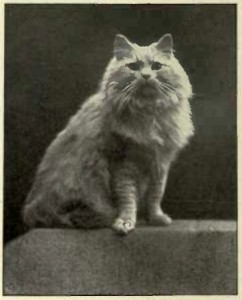
There are no cats exhibited in better coat and condition than those that come from the Romaldkirk cattery, and the Misses Beal may be justly proud of their splendid specimens of creams, oranges, tortoiscshells, and blue Persians. Miss W. Beal has kindly supplied me with a short article on cream and fawn Persians :—
“ The cream and fawn Persian was a few years ago looked upon as a ‚ sport,‘ and when cream kittens appeared in an orange strain they were considered spoilt oranges, and were either given away, sold for a few shillings, or in many cases destroyed as useless. Now, however, it is very different ; there is a growing demand for cats and kittens of this colour, and at the big shows they usually have two classes, i.e. male and female, for them. They were certainly slow in coming into general favour, owing, I think, to the following facts : First, that the specimens formerly exhibited failed very noticeably in head, being very narrow in face arid long in nose ; secondly, that cream females were practically unknown; and, thirdly, that a show, where they are generally seen, is emphatically the worst place to see cream Persians to advantage, as the journey and being in a town, etc., takes off the spotlessness of their coat and dulls their colour, and the dingy grey of the pens and the yellow of the straw combine to spoil the effect of their colour.
„The place, without doubt, to see creams to perfection is the country, where against a background of vivid green lawn their pure, soft colouring is indeed a thing of beauty, and rarely fails to command admiration. The colour is rather difficult to describe, and there are two distinct tones of colour bred, the one which is generally seen and is so far most successful at shows being a cream rather deep in shade, almost buff, with a distinct pink tinge about it, which is very different from the washed-out orange or sandy colour some people imagine it to be. The other tone of cream colour is much paler in shade, but, instead of the pink, it inclines to a lemon tinge, and, though paler, it is, as a rule, more ‚ flaky ‚ and uneven than the darker shades, and it is also very apt to fade into white underneath.
“ Nearly all the best-known creams are bred in the first place from orange and blue strains, though creams have appeared as freaks in many colours—silvers, tabbies, etc.; but I believe the present strains sprang from crossing blue and orange, and you can generally rely on getting some creams by crossing a tortoise-shell, cream, orange, or blue tortoiseshell queen with a blue sire. But, so far, reversing the mating, i.e. a blue queen with a cream or orange sire, is not successful from the cream breeders‘ point of view, though very good from that of those breeders who want blues, as the kittens generally excel in purity of colour. Cream females are now fairly common, and so in a few years there ought to be a well-established strain of cream-bred creams ; but, as in all other breeding for colour, people are apt to get surprises—for instance, one strain of cream females mated to a cream sire invariably produces whole litters of creams, while another strain, more cream-bred than the first named, mated to the same sire produces equal numbers of creams and orange-and-creams. If people wish to start breeding creams, and cannot afford a cream female, it is a good plan to buy a well-bred nondescript coloured female, either blue-and-cream, tabby, tortoiseshell, or anything that has cream or orange about it, and if it is properly mated there are nearly sure to be one or two creams : thus a cream strain can be gradually built up.
“ There are several things to be remembered in trying to breed good creams. One point to be aimed at is to keep the colour as level as possible, whether it be of a dark or light shade, and to keep it pure, not tinged with blue or dull. Among other faults to be bred out are the light lip and chin, which are very common defects, and the long head, which is still seen sometimes, though creams have improved vastly in this respect in the last few years. Creams have been taken up greatly in America as well as oranges, and there they seem to be formidable rivals in-popularity to the silvers, which have so far over here outdone them in that respect. “ One great point in favour of creams is their hardiness, for they do not possess the delicate constitutions which seem to belong to most of the other very pale varieties of Persians. With other coloured cats—blues, silvers, etc.— creams make a splendid contrast, and with oranges add greatly to the effect of a group. They also cross well with several colours— blue, black, tortoiseshell, etc.—for breeding; and many breeders think the result of the growing fancy for these colours, i.e. cream and orange—for, though so different, they are hard to deal with separately—will be that they will be better catered for at shows as to classes, and more extensively bred than they are at present.“
